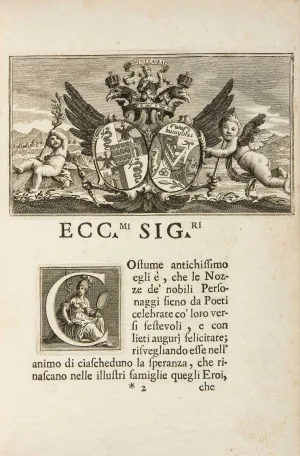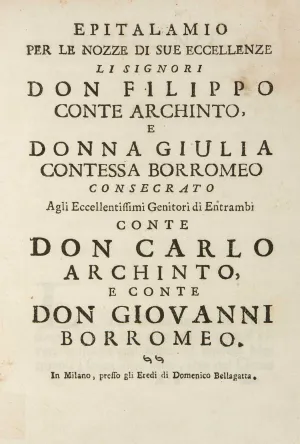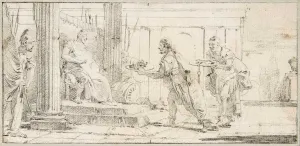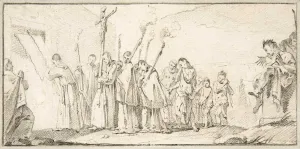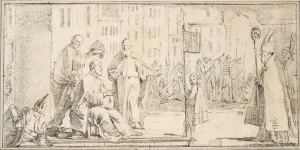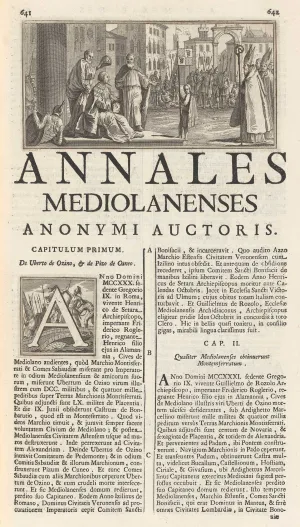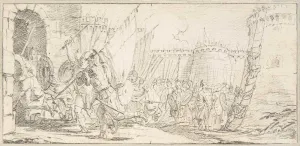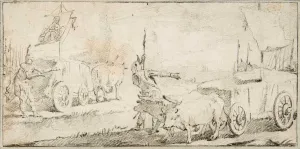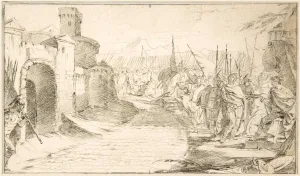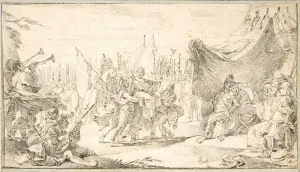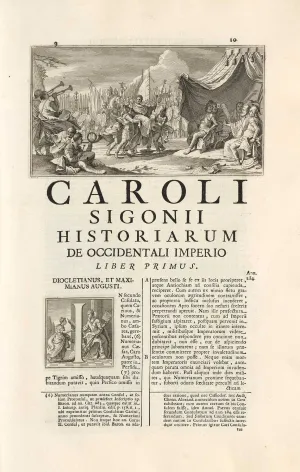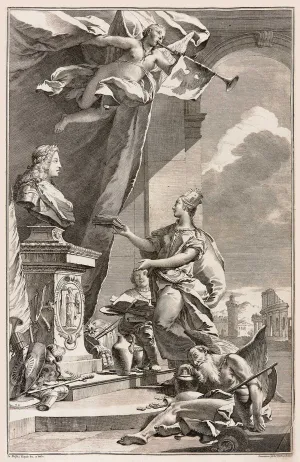Literary Connection
Dedication Page for Filippo Argelati's Le Ode di Anacreonte (Milan, 1731)
Biblioteca Nazionale Braidense, Milan
Su concessione del Ministero dei beni e delle attività culturali e del turismo; photo Mauro Ranzani
This book was produced as a wedding gift to Filippo Archinto and Giulia Borromeo, who married on April 22, 1731. Filippo Argelati, the Archinto family librarian, chose to dedicate to the couple some "amorous compositions": the Odes by Anacreon. The preface of the book opens with the two families' coats of arms (Archinto on the left and Borromeo on the right).
Frontispiece for Antonio Gantelmi's Epitalamio per le nozze di sue eccellenze li signori Don Filippo Archinto e Donna Giulia Contessa Borromeo (Milan, 1731)
Biblioteca Nazionale Braidense, Milan
Su concessione del Ministero dei beni e delle attività culturali e del turismo; photo Mauro Ranzani
Antonio Gantelmi published this short poem as a wedding gift to Filippo Archinto and Giulia Borromeo, who married on April 22, 1731. He dedicated it to Carlo Archinto and Giovanni Borromeo, the fathers of the groom and bride.
Giambattista Tiepolo (1696–1770)
Presentation of a Decapitated Head and the Keys to the City
Drawn for Ludovico Antonio Muratori, Rerum Italicarum Scriptores,
ca. 1725–30
Black chalk reworked with traces of red chalk on white paper
3 × 6 1/8 in. (75 × 155 mm)
The Metropolitan Museum of Art, New York
© The Metropolitan Museum of Art / Art Resource, NY
Giambattista Tiepolo (1696–1770)
The Italian Flagellant Movement
Drawn for Ludovico Antonio Muratori, Rerum Italicarum Scriptores, ca. 1725–30
Black chalk on white paper
3 1/8 × 6 1/2 in. (80 × 166 mm)
The Metropolitan Museum of Art, New York
© The Metropolitan Museum of Art / Art Resource, NY
Giambattista Tiepolo (1696–1770)
The Assassination of Count Ghiazolo in Rimini in 1326
Drawn for Ludovico Antonio Muratori, Rerum Italicarum Scriptores,
ca. 1725–30
Black chalk on white paper
2 7/8 × 6 1/8 in. (74 × 157 mm)
The Metropolitan Museum of Art, New York
© The Metropolitan Museum of Art / Art Resource, NY
Giambattista Tiepolo (1696–1770)
The Coronation of Henry VII in Milan in 1311
Drawn for Ludovico Antonio Muratori, Rerum Italicarum Scriptores,
ca. 1725–30
Black chalk on white paper
3 × 6 1/8 in. (77 × 156 mm)
The Metropolitan Museum of Art, New York
© The Metropolitan Museum of Art / Art Resource, NY
Francesco Zucchi (1672–1750) after Giambattista Tiepolo (1696–1770)
The Coronation of Henry VII in Milan in 1311
From Ludovico Antonio Muratori, Rerum Italicarum Scriptores (Milan, 1723–51), vol. 16
Columbia University Libraries, Columbia University in the City of New York
Columbia University Libraries, Columbia University in the City of New York
Tiepolo provided delicate designs for a number of engravings by Francesco Zucchi for many of the volumes of Muratori's Rerum Italicarum Scriptores. One of the headpieces of volume 16 relates to the text it introduces: an anonymous account of the history of Milan. Tiepolo depicted the coronation of Emperor Henry VII as King of Italy, which took place in Milan on January 6, 1311. The original drawing for this print is also shown in the exhibition.
Giambattista Tiepolo (1696–1770)
Siege of a City
Drawn for Carlo Sigonio, Opera Omnia, 1730–31
Black chalk on white paper
2 7/8 × 6 in. (73 × 151 mm)
The Metropolitan Museum of Art, New York
© The Metropolitan Museum of Art / Art Resource, NY
Giambattista Tiepolo (1696–1770)
The Exchange of Ox Carts between Parma and Cremona in 1281
Drawn for Ludovico Antonio Muratori, Rerum Italicarum Scriptores,
ca. 1725–30
Black chalk on white paper
3 × 6 in. (76 × 154 mm)
The Metropolitan Museum of Art, New York
© The Metropolitan Museum of Art / Art Resource, NY
Francesco Zucchi (1672–1750) after Francesco Zugno (1709–1787)
Alberico Archinto and an Allegory of the Catholic Faith
From Carlo Sigonio, Opera Omnia (Milan, 1732–37), headpiece for vol. 5
Columbia University Libraries, Columbia University in the City of New York
Carlo's son, Alberico Archinto, pursued an ecclesiastical career and was among the scholars who annotated parts of the Rerum Italicarum Scriptores and supported the Società Palatina. The fifth volume of Sigonio's Opera Omnia was dedicated to Alberico, whose portrait, accompanied by an allegory of the Catholic Faith, appears on the headpiece. This was designed by Tiepolo's pupil and collaborator, Francesco Zugno, whose original drawings for this print are at the Metropolitan Museum of Art, New York, and the Castello Sforzesco, Milan.
Giambattista Tiepolo (1696–1770)
Siege of a City
Drawn for Ludovico Antonio Muratori, Rerum Italicarum Scriptores,
ca. 1725–30
Black chalk on white paper
4 3/8 × 7 1/2 in. (112 × 192 mm)
The Metropolitan Museum of Art, New York
© The Metropolitan Museum of Art / Art Resource, NY
The preparatory drawings Tiepolo made to accompany the medieval texts collected by Muratori in Rerum Italicarum Scriptores represent scenes from Italian history. Many of the events depicted cannot be precisely identified, however, and on more than one occasion, the drawings are used multiple times, to illustrate different events.
Giambattista Tiepolo (1696–1770)
Triumph of a Roman Emperor
Drawn for Carlo Sigonio, Opera Omnia, 1730–31
Black chalk reworked with traces of red chalk on white paper
4 3/8 × 7 1/2 in. (110 × 191 mm)
The Metropolitan Museum of Art, New York
© The Metropolitan Museum of Art / Art Resource, NY
Francesco Zucchi (1672–1750) after Giambattista Tiepolo (1696–1770)
Triumph of a Roman Emperor
From Carlo Sigonio, Opera Omnia (Milan, 1732–37), headpiece for vol. 1
Columbia University Libraries, Columbia University in the City of New York
One of the publications produced by the Società Palatina was the six-volume Opera Omnia, the collected works of the sixteenth-century historian Carlo Sigonio. The headpiece for the first volume — representing the triumph of an ancient Roman emperor as he is carried by his generals to a tent — is based on a drawing by Tiepolo.
Francesco Zucchi (1672–1750) after Giambattista Tiepolo (1696–1770)
Italy Presenting the Volume to Charles VI
From Francesco Mediobarbo Birago, Imperatorum Romanorum Numismata (Milan, 1730), frontispiece
Mount Holyoke College Archives and Special Collections, South Hadley
The Imperatorum Romanorum Numismata, dedicated to Emperor Charles VI in Vienna, was the last of the Società Palatina volumes with which Tiepolo was involved. Its subject is the study made by Francesco Mediobarbo, Count of Birago, of two hundred thirty-five ancient Roman coins, dating from the age of Pompey to the age of Emperor Heraclius. The frontispiece features the personification of Italy presenting the book to the emperor, shown in the form of a bust against a background of ancient ruins.

